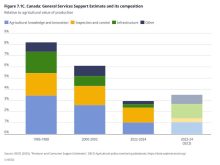Giving the grain-handling and transportation sector a more commercial orientation would improve its efficiency and speed up the movement of wheat from terminals to ports, says a report issued by the Conference Board of Canada.
“The greater flexibility allowed by regulators has helped to address some of the industry concerns, with the result that performance across the entire supply chain has improved since 1999,” the report notes. “There remains, however, room for improvement.”
Priority items for consideration by the federal government and the industry should be expanded competitive tendering for the movement of Canadian Wheat Board grain, a review of the annual railway grain revenue cap and improving the flow of information between the railways and shippers, says the report prepared by the board’s Centre for Transportation Infrastructure.
Read Also

Manitoba Ag Days 2026 coming up fast
Canada’s largest indoor farm show, Manitoba Ag Days, returns to Brandon’s Keystone Centre Jan. 20-22, 2026. Here’s what to expect this year.
The government should go further in relaxing regulatory oversight of the grain sector to speed up grain movement and lower costs for farmers, the report added.
“Since 1999, Canadian grain for export has generally experienced a decline (with significant annual fluctuations) in transit time. This has occurred due to the reduction in time spent in country elevators and to a lesser extent, rail transit times.
The centre’s “analysis of transportation times finds that CWB grains have typically spent more time in the supply chain than non-CWB grains, primarily because of longer storage time in country elevators,” the report notes. “Wheat, for example, was stored approximately 35 days on average in 2008-09; the canola average was just over 20 days.”
The report says treating wheat the same as non-board grains “may be able to yield further benefits,” the report continued.
“Measures taken to better facilitate the flow of information between railways and shippers – particularly transit time delays – would allow shippers to avoid delay costs,” the report says. “In this case, it appears the railways are starting to make some progress.”
The report says that as “the railways reach the revenue cap each year, they have no further incentive to make investments or divert resources to grain logistics to reduce the costs in the grain supply chain.”
The total cost of moving export grain to ports affects both their competitiveness and returns to the producer “and the time taken to move grain is an important indicator of efficiency.”
The federal government moved in 2000 to replace distance- based rates with a cap on overall railway revenue from grain, the report says. “This allowed the railways to provide rate incentives to shippers for larger movements of grain. The larger movements in turn allowed the railways to run trains with fewer stops and less switching time. The most visible impact of these reforms has been to reduce the number of country elevators from more than 1,000 in 1999 to less than 400 in 2009, as well as faster rail transit times.”














